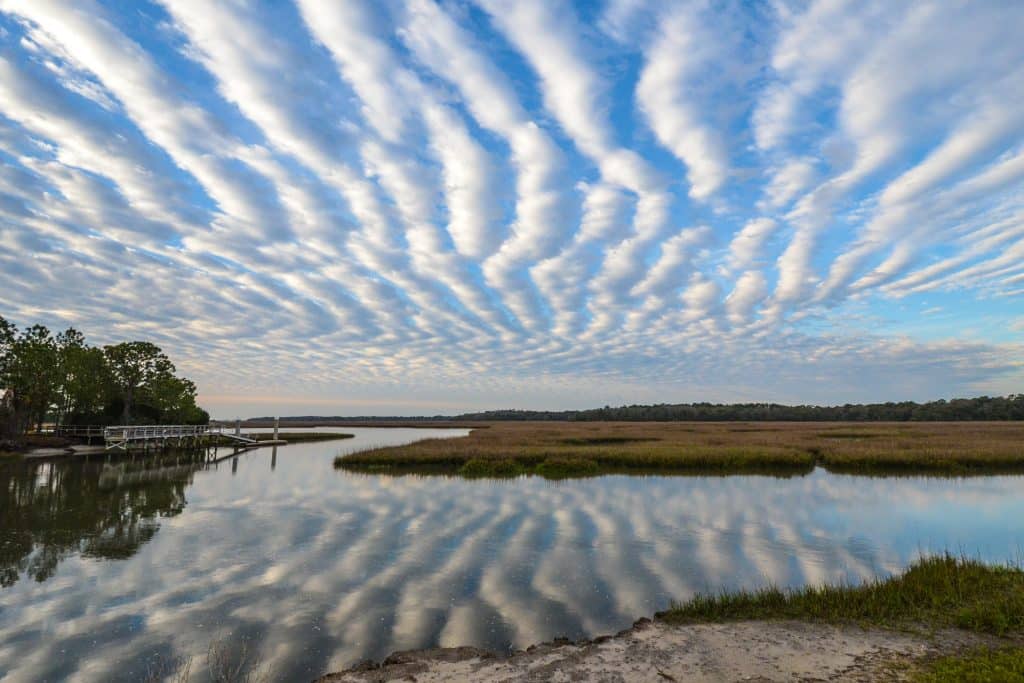
18 weeks until our birthday! North Florida Land Trust officially began its journey as a nonprofit in December 1999 and has remained committed to improving the quality of life through the protection of North Florida’s irreplaceable natural environment for 25 years. As we approach our official 25th birthday on December 27, we’re sharing stories about NFLT—our origins, our achievements, and our ongoing work. This week, we’re highlighting a conservation effort we’ve been a part of since May 2021—the South Atlantic Salt Marsh Initiative, or SASMI.
SASMI is a regional partnership focused on protecting and restoring vital salt marsh ecosystems along the southeastern coast of the United States. This initiative, which extends from North Carolina to Florida, aims to safeguard these ecologically significant areas that are under increasing threat from climate change, development, and other environmental pressures. The goal of SASMI is to conserve and restore the approximately 1 million acres of salt marshes within the South Atlantic states to ensure their long-term survival and to protect the benefits these wetlands provide for fish, wildlife, and people.
Before we dive in, let’s review why salt marshes are so important.
- 75% of commercially and recreationally caught fish and shellfish species depend on salt marshes and the estuaries that support them.
- On average, salt marshes provide $695,000 of value per square mile during storms by reducing the impacts of surge and flooding, according to a University of California, San Diego study.
- During storms, salt marshes absorb flood waters and wave energy, decreasing property damage in adjacent communities by up to 20%, according to NOAA.
- One acre of salt marsh can absorb up to 1.5 million gallons of floodwater, which is equivalent to more than 2.25 Olympic-size swimming pools.
- Salt marshes maintain coastal water quality by filtering runoff and excess nutrients.
- Salt marshes provide important habitat for a variety of birds, including popular waterfowl and imperiled species such as the Eastern black rail, wood stork, and saltmarsh sparrow.
- Salt marshes sequester and store carbon at a rate 10 times that of mature tropical forests
- The U.S. has approximately 3.8 million acres of salt marshes. Three-quarters of them are in the Southeast, including a vast interconnected 1 million-acre stretch from North Carolina to Florida.
- NOAA estimates that the U.S. loses 80,000 acres of coastal wetlands, including salt marshes, each year, mostly due to due to development and sea-level rise.
How is NFLT involved with SASMI?
In May 2023, SASMI released a long-term, regional salt marsh protection plan, entitled “Marsh Forward: A Regional Plan for the Future of the South Atlantic Coast’s Million-Acre Salt Marsh Ecosystem”. This plan was developed with input from a wide variety of stakeholders and serves as a comprehensive and forward-thinking guide for future development, restoration projects, land conservation, and species protection that will promote healthy and resilient coastal marshes.
While the SASMI regional plan outlines important strategies, objectives, and actions aimed at protecting and restoring salt marshes, most of the plan’s implementation will occur at the state and local levels. The success of the SASMI regional plan relies on the establishment of teams within each SASMI state, tasked with identifying and executing priority actions. The Florida “State Implementation Team” (FSIT) will lead SASMI’s on-the -ground implementation efforts in Florida. NFLT is leading the effort to convene a diverse group of partners who will work together to identify and prioritize specific long- and short-term projects that will advance salt marsh protection and restoration throughout Northeast Florida. The FSIT partners will then work to fund and implement those projects, completing on-the-ground actions to achieve the goals of the SASMI regional plan. These partners represent multiple sectors and interests, including state agencies, the Department of Defense, local counties and municipalities, mosquito control districts, nonprofit organizations, cultural groups, recreational fisherman, and landowners, to name a few. The FSIT is designed to be complementary to existing projects and efforts partners are already undertaking throughout the region. The team will facilitate collaboration and communication amongst partners to maximize their collective efforts.
NFLT’s involvement in SASMI highlights its commitment to preserving one of the most valuable and threatened ecosystems in the region. Protecting North Florida’s salt marshes is essential not only for maintaining the ecological health of these environments but also for supporting the myriad species that depend on them and ensuring that future generations can continue to enjoy and benefit from these critical natural resources.
Interested in learning more about NFLT’s work with SASMI? Check out our blog feature on Heather Nagy, NFLT’s staff lead with SASMI. You can also read about our work with SASMI in the Summer 2023 edition of Landscapes, NFLT’s bi-annual newsletter.
Do you have a story about how NFLT has touched you, or was there an acquisition or specific impact we made that resonated with you? We would love to hear it! Please email our Communications Officer, Sarah Hande, at shande@nflt.org with anything you want to share. It is our followers, readers, members, and supporters who make all of this possible – it’s now or never!






